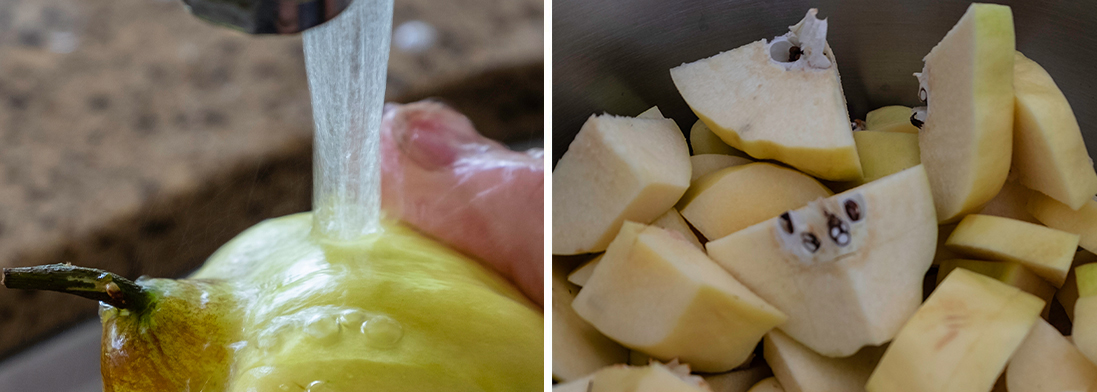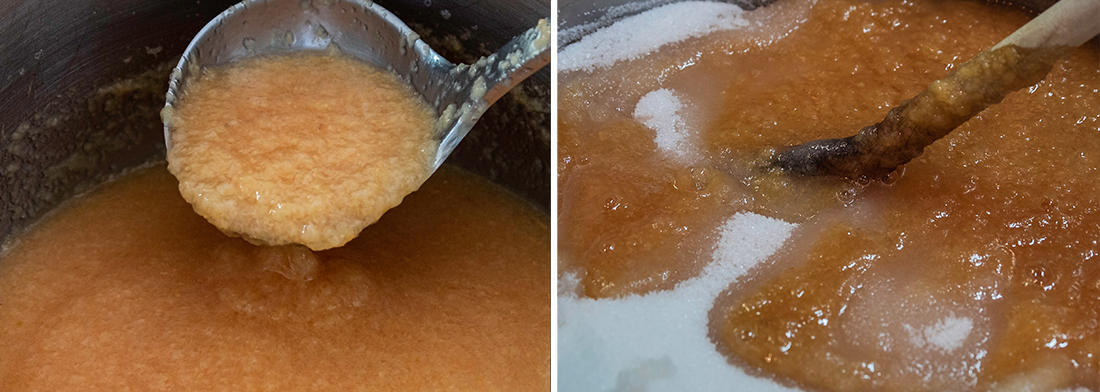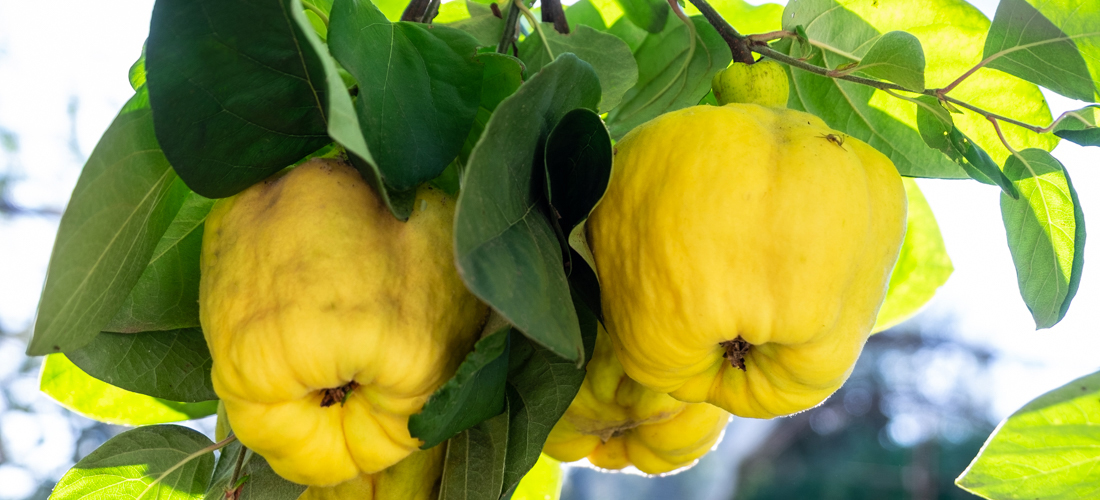Quince Paste
- Fruit Cheeses, Butters & Curds

A container of quince paste is an indispensable pantry staple and goes a long way. Easy to make, economical and versatile, it can be used as a sweet or savoury accompaniment. Quince paste stores well in the pantry and is a perfect pairing for roast meat, game, or cheese. Deep red and fragrant, it makes a culinary statement on a plate or cheese board and the perfect gift for the gourmands in your life.
A home-made cheese board basket is a very personal way to say thank you or for special occasions. Fill up a wicker basket or colourful gift box with home-made crackers, your own dried fruit, and a selection of nuts. Then add some coloured cellophane, ribbons, a card and its ready. Alternatively cut into small pieces, dredge in sugar, and serve as an after-dinner treat, to add a touch of luxuriance.
Once mastered, the techniques can be applied to apples, plums, peaches, pears, and medlars.
- Preparation Time:
- 15 minutes
- Cooking Time:
- 2 hours
- Quantity:
- 5 x 300ml food grade plastic containers
PREPARATION
Food grade plastic containers with sealable lids.

INGREDIENTS
- 1 kg
- Quince, ripe
- To cover quinces
- Water
- 500g to each 500g puree
- Sugar, white

METHOD
Making pastes are not difficult but is does take time and patience. Be prepared for the stirring, make your favourite beverage, set the music, or pod cast and enjoy the rhythm of slow food. And keep stirring!
Gently wash the quinces to remove the soft down covering the fruit. Without peeling or removing the pips, cut into pieces approximately 4 to 5 cm.
Place in a large stockpot or preserving pan and just cover the fruit with water.
Simmer gently for approximately 1-1.5 hours or until the quinces are thoroughly cooked and are soft and pulpy. The quince colour may begin to change progressively from creamy light yellow to a soft pink colour. Allow to cool.
Pulp the fruit mixture using either a food mill or through a fine sieve. Remove any pips.
Measure the puree and return to a clean heavy-bottom wide stock pot or preserving pan brushed lightly with glycerine on neutral flavoured cooking oil. Warm with fruit mixture gently and add an equal amount of sugar, stir until the sugar is dissolved. Bring to the boil, stirring constantly.
Reduce to a simmer and continue to stir constantly until the paste thickens, comes away from the bottom on the pan and holds its shape for several seconds before coming together again.
Take care as the boiling mixture will bubble and spit as it thickens.
Remove from the heat and ladle into food grade containers. Allow to cool completely before sealing.
NOTES
- Make quince past in small batches as this reduces the cooking and stirring time. Larger batches are more prone to sticking on the bottom if not constantly stirred.
- The quince must be cooked thoroughly and be very soft and pulpy in Step 1 so it can be easily sieved. Vitamising the fruit mass is not recommended as it will become aerated, and the pips will be pulverised creating a gritty paste.
- A sturdy heavy-bottom stock pot or preserving pan must be used when making pastes to distribute the heat evenly across the base. This helps to prevent the paste from catching on the bottom and potentially burning even though its constantly stirred. Long, slow continuous cooking is essential to transform the creamy yellow/pinkish fruit mass into a thick luscious deep ruby coloured paste that can be easily unmoulded.
- Lightly brushing preserving pan with glycerine or a neutral flavoured oil will help prevent the fruit from catching on the bottom of the pan. Food grade glycerine is available either in the baking section in supermarkets or at a pharmacy.
- To make a sweetmeat treat to serve with after-dinner coffee pour the cooked paste into shallow rectangular swiss roll (jelly roll) pan lined with parchment, waxed, or baking paper. and allow to cool overnight. Next day, place in the oven at its lowest temperature and leave until the paste dries out and is very firm. This will take couple of hours. The oven must be on its lowest possible setting to dry out but not cook the paste. Turn out and cut into small serving sized pieces, roll in fine caster sugar and serve. Store in airtight containers or in the fridge.
- Variations: Plum, apple, medlar and pear. Use the same method as for making a quince paste
What can go wrong?
- Burning: Preserving pot did not have a heavy base and/or sugar not dissolved before boiling, not stirred constantly.
- Mould: Containers filled to the top, not dried properly prior to filling/sealing and/or incorrect storing.
- Air bubbles: Paste poured into container too slowly.
- Not thick enough: Insufficient cooking.
What’s in a name? The difference between fruit curd, butter, cheese, and paste
It’s all in the ingredients, cooking time and final consistency.
Fruit curds: Made from fruit juice, typically citrus, sugar and enriched with butter and eggs and simmered gently. Definitely no boiling . or you get fruit flavoured scrambled eggs. Must be refrigerated and does not have a long storage life.
Fruit butter: Fruit puree and sugar boiled together until thick and creamy. Contains a lower proportion of sugar than fruit cheese/paste. A generous knob of butter at the end adds an irresistible gloss. Buts it’s not optional. Curds and butters are spreadable and delicious spooned onto toast, and often used as tart and cake fillings. Perfect for swiss rolls.
Fruit cheese /paste: Term used interchangeably. Fruit pulp and sugar boiled together to a thick firm consistency. Can be cut or set in individual moulds and served as a delicious accompaniment to roast meats, on a cheese board or served in smaller pieces, dredged in sugar. It was a popular after-dinner sweetmeat in Edwardian and Victorian period.
 Smyrna variety of quince in our abundant kitchen garden
Smyrna variety of quince in our abundant kitchen garden
